Finishing Options for River Tables & Other Epoxy/Wood Projects
Update: August 2023: Osmo PolyX and Osmo Top Oil continue to be my goto finishing options for most my projects. I also updated a few of my notes based on long term use.
I’m on a quest to find the best finish for epoxy river tables and similar products, such as my wood river placemats. No product is perfect, and here are my opinions on various options, ordered by preference. I prefer a satin finish, and my recommendations are based on that. Some links are Amazon affiliate links, but I am in no way endorsing one product over another and my opinions are not biased.
Notes: Oil based finishes are incredibly easy to apply; spray-based finishes require more equipment (like an HVLP); prices are based on March 2020.
Some finishes are food safe, some are not!
Osmo PolyX Oil
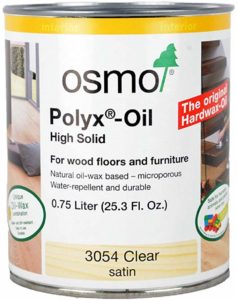
- Osmo Website: https://osmo-store.com
- Polyx-Oil – $50/0.75 liter ($250/gallon, not food safe), [Affiliate link]
- Top Oil (food safe version) $37/0.5 liter ($285/gallon) [Affiliate link]
Osmo oil is easy to apply; just rub it on and wipe it off. Apply two – three coats. Optionally buff it. A little goes a long way. Requires about 8-10 hours of drying between coats.
Pretty water resistant. I’ve been using it on a lot of boxes. I’m not sure how well it does against scratches; for most tables I’ve been using the next product (conversion varnish). A lot of people use it for table tops, and it is good for floors and must be very durable.
Polyx-oil is “kid safe” but not “food safe”. The “Top Oil” version is food safe, but it isn’t as natural of a product as Tried and True or Walrus Oil, as it contains drying agents. I’ve used it on some bowls and it works quite well, as Osmo Top Oil is my goto finish for most my bowls (but not utensils).
General Finish Conversion Varnish
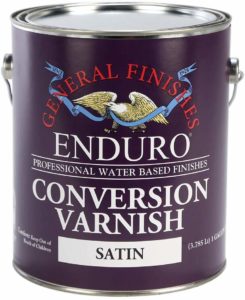
- Purchase: Amazon Prime – $120/gallon [Affiliate link]
- Purchase catalyst: Amazon Prime – $13 / (enough for 1 gallon)
- Note: you can possible find this in other places for cheaper with the catalyst included
- Not food safe
Very durable. I’ve used it for some tops, such as my black river bar top and epoxy river placemats. It will show scratches after a while due to dragging stuff over it.
Difficult to apply: requires a spray gun. However, you can apply 3-4 coats in 3-4 hours and be done with it, whereas some other finishes require 12 hours of drying in between. You do have to sand before the final coat, which takes more time.
Requires mixing with a catalyst, which has a specific pot life.
Very water resistant. Not “officially” food safe, but I have eaten off it when food falls on my placemats.
This is my preferred finish for tops; it can be difficult to get it to lay without any defects. When spraying you have to wear a respirator.
Tried & True – Danish Oil or Original Wood Finish
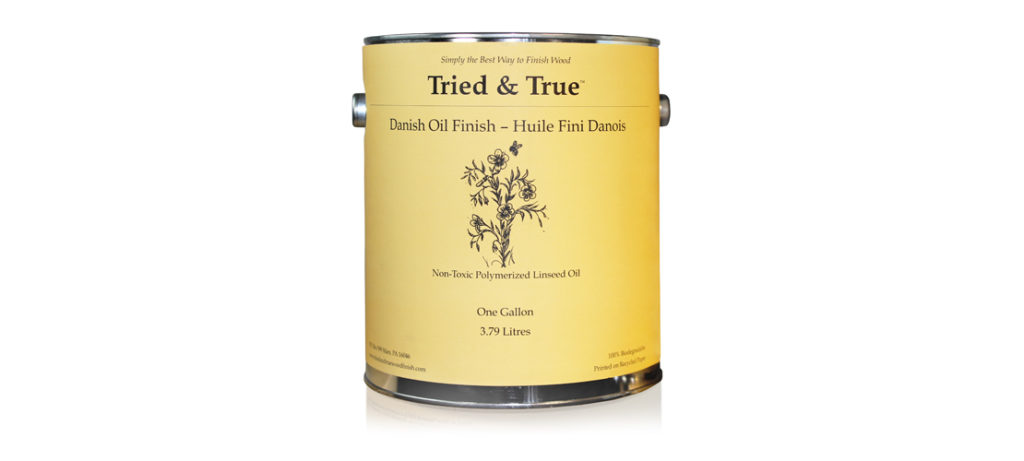
- Website: Tried & True
- Purchase: Tried & True on Amazon – $23 to $25/pint (~$184 gallon) [Affiliate link]
- Food safe
I’ve been using it on my bowls because it is 100% food safe and starts to give a little bit of a shine after a few coats. I’ve been using the basic Danish Oil finish, but I want to try their original finish too. Both have polymerized linseed oil; a very natural finish. I do like this product, but I tend to prefer Osmo Top Oil when I need a food safe finish, as it has a better shine to it, and is a lot more durable.
I prefer it over the related food safe product, Walrus Oil. It tends to add more of a shine. Walrus oil is better for cutting boards and utensils, as linseed oil has a fairly strong smell, whereas the Walrus Oil does not. I lean towards Osmo Top Oil for durability, but I like that this finish is 100% natural.
Target Coatings (Various Options)
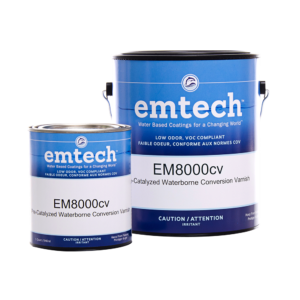
- Website/Purchase: https://www.targetcoatings.com
- EM6000 lacquer – slightly amber, less durable, but easier and faster to spray
- EM7000HBL laquer – more clear, more durable, more time between coats
- EM8000cv Conversion Varnish – I haven’t used this yet!
- Not food safe
I’ve used Target Coating’s water based finishes a lot for general woodworking projects and kitchen cabinets. They require you to spray them, which is a non-starter for some people.
Overall, I love the finish for most woodworking, but I don’t like it on epoxy; it tends to orange peel. However, I want to try the conversion varnish!
Spraying on epoxy is tricky: the first coat usually looks really orange-peel like on the epoxy, and has adhesion problems. If you sand it with 400 grit and spray again you’ll get better adhesion. You need to do 3-4 coats, which takes time.
The advantage of this spray over the conversion varnish is that you don’t have to mix any catalyst, and can pour any unused finish back in the can.
The disadvantage is that the finish isn’t quite as durable as the two-part finishes – I can usually dent it with my fingernail. I want to try their Conversion Varnish with CL100 CrossLinker, and I’ll probably purchase it when I run out of the General Finish conversion varnish that I have on hand.
Rubio Monocoat Oil+2C
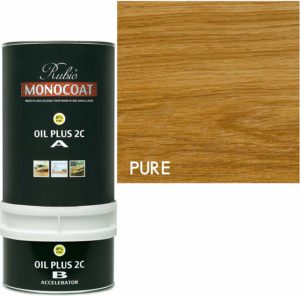
- Website: Rubio Monocoat Website
- Purchase: Rubio Monocoat on Amazon Prime – $50/0.35L – ($543/gallon!)
- Not food safe, not for cutting boards.
Incredibly expensive for the amount you get, but a little does go a long way and it only requires one coat so you might use half as much. However, you have to guess how much you need and mix it with the accelerator, and once you do this you have to toss any extra that you have.
The oil has quite a strong smell to it when you apply it, but it apparently low VOC. It is really easy to apply.
The biggest disadvantage to this product (especially compared to non-mixed oil products, such as Osmo oil or Odies oil), is the containers. The container for the accelerator is hard to open. It is a small paint-can style container. The lid is hard to put back on, and any extra product left on the lid makes it even harder to open the next time. Eventually you will distort the lid and not be able to get it back on securely enough, and the accelerator will dry out. This will waste a lot of the oil (I lost about 1/4 of a can). Because of this, I do not recommend Rubio Monocoat! I emailed Rubio to tell them about this problem; I’ll update my review when I hear back from them.
However, Rubio does have a lot of stain options. If you are looking to stain your wood then this might be an awesome finish to use.
It is not food safe. I’ve had people argue with me about this, but it explicitly says so on the Rubio website’s FAQs. They also say to not use it on cutting boards. The confusion comes from them listing it as non-toxic. However, in 2021 they did update their website to say it has passed approval for food contact (which is not the same as food safe).
Countertop Epoxy Finish
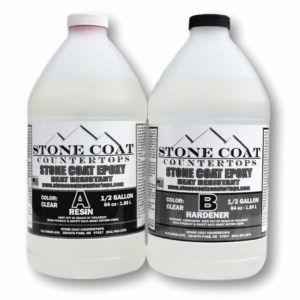
- List of Countertop Epoxy Suppliers – $70-$100/gallon
- Not food safe
You can simply do three coats of a countertop grade epoxy onto your project and call it done. However, I’ve noticed that I sometimes have to do 4 (or more) coats to get it perfectly even. I did a high gloss epoxy finish on my Blue River Spalted Oak Coffee Table. It looks great! I didn’t personally use it, and sold the table. I know a lot of people use countertop epoxy in their kitchens, and they say it is pretty durable but will eventually get scratches.
The biggest disadvantages: it requires a minimum of three coats, and each coat takes a day or so to dry. You (probably) have to sand between coats. The finish will be glossy, which can be a plus or minus. You can “hone” out the gloss with fine sandpaper (1000+ grit) to make a satin finish, but this requires a lot of time.
The epoxy is also quite expensive compared to other finishes, and takes a lot more time.
Epoxy is fine for incidental contact with food, but it is not considered food safe. I have an article on this: is epoxy food safe?
Walrus Oil Brand – Cutting Board Oil
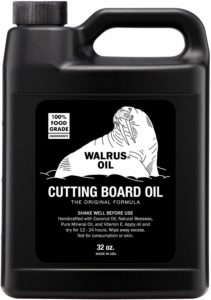
- Website: https://walrusoil.com
- Purchase: Walrus Oil on Amazon Prime – $25/32oz ($100/gallon)
- Food safe
I used this on some of my earlier wooden bowls, but now I prefer Osmo Top Oil for bowls. But for wood spatulas, spoons, utensils, and cutting boards I prefer Walrus Oil. This is because I feel like Osmo Top Oil will chip off when used as a utensil, and the oil will not chip off due to it being soaked into the wood. Osmo Top Oil would *definitely* chip off with a cutting board, and I wouldn’t ever use it there.
It looses its shine after a few washings, and will need re-coating over time.
Easy to apply; spread some on, wait 12 hours for it to absorb, and wipe off any excess. You can apply on a wax on top for more waterproofing.
Quite waterproof when you use their thicker wax on top of it.
Definitely not scratch proof. I wouldn’t use it on something that I want to be more durable, like a table top.
Mineral oil is another basic topping you can use instead of this product. Walrus Oil doesn’t really smell much and kind of smells good (I bet it has some coconut oil in it), whereas linseed oil has a rather strong smell that takes several days to dissipate.
Odies Oil
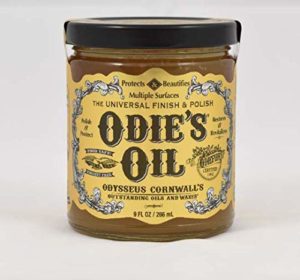
- Website: Odie’s Oil
- Purchase: Odie’s Oil on Amazon Prime – $43/9oz ($311/gallon)
- Food safe
I haven’t used this product yet, but a lot of people swear by it so I’m including it in my list. It is quite expensive.
People say a little oil goes a long way, so it may be worthwhile.
This brand also has other products; check out their website for more details.
Food safe! Good for cutting boards and bowls.
Polyaspartic Coating
I’ve seen some recommendations for a polyaspartic coating to provide something good for outdoor use. My understanding is that it is similar to epoxy but a different formula, and has high UV resistance. I need to research this option more; if anyone has experience or brand recommendations, please email me! (corbin at corbinstreehouse dot com)
Not food safe.



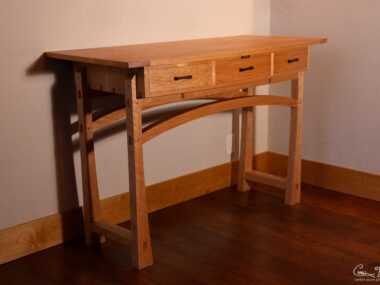


Do you have any experience with putting conversion varnish over osmo extra thin and polx? Ive already finished a table top with the Osmo route, but would really like to cover that in conversion varnish if possible. Thanks for your thoughts!
Hi Dan, that is is not something I’ve tried! Osmo polyx seems to dry really hard after a week or so. I’d check the full cure time on the package. Try sanding some inconspicuous area and do a test. If the sanding area sands well (turns milky/opaque), then a coat of conversion will probably stick to it. But, I don’t know the official answer! Personally, I’m not sure if I’d try it on a finished piece, unless I was really unhappy with the finish. I’d stick with 2-3 coats of Osmo.